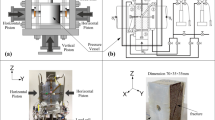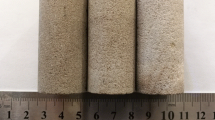Abstract
A series of stress relaxation experiments have been carried out on faulted and intact Tennessee sandstone to explore the influence of pore water on strength at different strain rates. Temperatures employed were 20, 300 and 400°C, effective confining pressure was 1.5 kb and strain rates as low as 10−10 sec−1 were achieved. Most samples were prefaulted at 2.5 kb confining pressure and room temperature. This is thought to have secured a reproducible initial microstructure.
The strength of the dry rock was almost totally insensitive to strain rate in the range 10−4 to 10−10 sec−1. In contrast, the strength of the wet rock decreased rapidly with strain rate at rates less than 10−6 sec−1. Brittle fracture of the quartz grains which constitute this rock is the most characteristic mode of failure under the test conditions used.
The experimental data are discussed in terms of the possible deformation rate controlling processes, and it is suggested that in the wet experiments at intermediate to high strain rates (10−7 to 10−4 sec−1) the observed deformation rate is controlled by the kinetics of water assisted stress corrosion, whilst deformation at low strain rates (ca. 10−9 sec−1) is controlled by a pressure solution process.
The results have implications for the rheology of fault rocks at depths of perhaps 10 to 15 km in sialic crust.
Similar content being viewed by others
References
Atkinson, B. K. (1975).Experimental deformation of polycrystalline pyrite; effects of temperature, confining pressure, strain rate and porosity, Econ. Geol.70, 499–514.
Ball, A. andPayne, B. W. (1976),The tensile fracture of quartz crystals, J. Mat. Sci.11, 731–740.
Boozer, G. H., Hiller, K. H. andSerdengecii, S.,Effects of pore fluids on the deformation behaviour of rocks subjected to triaxial compression inRocks Mechanics (ed. C. Fairhurst), (Pergamon Press, London, 1963), pp. 579–625.
Brace, W. F. andMartin, R. J. (1968),A test of the law of effective stress for crystalline rocks of low porosity, Int. J. Rock Mech. Min. Sci.5, 415–426.
Brune, J. N. (1974),Current status of understanding quasi-permanent fields associated with earthquakes, Trans. Am. Geophys. Union55(9), 820–827.
Charles, R. J.,The strength of silicate glasses and some crystalline oxides inProceedings of the International Conference on Fracture, (M.I.T. Press, Cambridge, Mass. 1959), pp. 225–249.
Colback, P. S. B. andWiid, B. L. (1965),The influence of moisture content on the compressive strength of rocks, Proc. Rock Mech. Symposium, Univ. Toronto, 65–83.
de Boer, R. B., Nagtegaal, P. J. C. andDuyvis, E. M. (1977),Pressure solution experiments on quartz sand, Geochimica et Cosmochimica Acta,41, 257–264.
Donath, F. A. andFruth, L. S. (1971),Dependence of strain rate effects on deformation mechanism and rock type, J. Geol.,79, 347–371.
Dorn, J. E.,The spectrum of activation energies for creep inCreep and Recovery, (Am. Soc. for Metals, Cleveland, Ohio, 1957), pp. 225–283.
Elliott, D. (1976),The energy balance and deformation mechanisms of thrust sheets, Phil. Trans. Soc. Lond.A283, 289–312.
Engelder, J. T. (1974),Cataclasis and the generation of fault gouge, Geol. Soc. Am. Bull.85, 1515–1522.
Engelder, J. T., Logan, J. M. andHandin, J. (1975),The sliding characteristics on sandstone on quartz fault gouge, Pure app. Geophys.113, 69–86.
Evans, A. G. (1973),A simple method for evaluating slow crack growth in brittle materials, Int. J. Fract.9, 267–275.
Evans, A. G. andJohnson, H. (1975),The fracture stress and its dependence on slow crack growth, J. Mat. Sci,10, 214–222.
Friedman, M., Logan, J. M. andRigert, J. A. (1974),Glass indurated quartz gouge in sliding friction experiments on sandstone, Geol. Soc. Am. Bull.,85, 937–942.
Gallagher, J. J., Friedman, M. andSowers, G. M. (1974),Experimental studies relating to microfracturing in sandstone, Tectonophysics21, 203–247.
Guiu, F. andPratt, P. L. (1964),Stress relaxation and the plastic deformation of solids, Phys. Stat. Sol.6, 111–120.
Gupta, I. andLi, J. C. M. (1970a),Stress relaxation, internal stress and work hardening in LiF and NaCl crystals, Mat. Sci. and Engineering,6, 20–26.
Gupta, I. andLi, C. J. M. (1970b),Stress relaxation, internal stress and work hardening in some BCC metals and alloys, Metall. Trans.1, 2323–2330.
Jackson, R. E. andDunn, D. E. (1974),Experimental sliding friction and cataclasis of foliated rocks, Int. J. Rock Mech. Min. Sci.11, 235–249.
Lawn, B. R. (1975),An atomistic model of kinetic crack growth in brittle solids, J. Mat. Sci.10, 469–480.
Martin, R. J. (1972),Time dependent crack growth in quartz and its application to the creep of rocks, J. Geophys. Res.,77, 1406–1419.
Martin, R. J. andDurham, W. B. (1975),Mechanisms of crack growth in quartz, J. Geophys. Res.80, 4837–4844.
Nason, R. andWeertman, J. (1973),Adislocation theory analysis of fault creep events, J. Geophys. Res.78, 7745–7751.
Nur, A. (1975),A note on the constitutive law for dilatancy. Pure app. Geophys.113, 197–206.
Raleigh, C. B. andKirby, S. H. (1970),Creep in the upper mantle, Min Soc. Am. Spec. Paper3, 113–121.
Raj, R. andAshby, M. F. (1971),On grain boundary sliding and diffusional creep, Metall. Trans.2, 1113–1126.
Rutter, E. H. (1972),The influence of water on the rheological behaviour of calcite rocks, Tectonophysics14, 13–33.
Rutter, E. H. (1974),The influence of temperature, strain rate and interstitial water in the experimental deformation of calcite rocks, Tectonophysics22, 311–334.
Rutter, E. H. (1976),The kinetics of rock deformation by pressure solution, Phil Trans. Roy Soc. Lond.A283, 203–219.
Rutter, E. H. andSchmid, S. M. (1975),Experimental study of unconfined flow of Solnhofen limestone at 500 to 600°C, Geol. Soc. Am. Bull.86, 145–152.
Schmid, S. (1976),Rheological evidence for changes in the deformation mechanism of Solnhofen limestone towards low stresses, Tectonophysics31, T21-T28.
Scholz, C. H. (1968),Microfracturing and the inelastic deformation of rock in compression, J. Geophys. Res.73, 1417–1432.
Scholz, C. H., Wyss, M. andSmith, S. W. (1969),Seismic and aseismic slip on the San Andreas fault, J. Geophys. Res.74, 2409–2069.
Sibson, R. H. (1977),Fault rocks and fault mechanisms, J. Geol. Soc. Lond.133, 191–214.
Sprunt, E. S. andNur, A. (1976),The reduction of porosity by pressure solution: experimental verificati Geology,4, 463–466.
Stesky, R. M. andBrace, W. F.,Estimation of frictional stress on the San Andreas fault from laborat measurements inProc. Conf. on Tectonic Problems of the San Andreas Fault System (eds. R. Kov and A. Nur), (Stanford University Publication, Stanford, California, 1973), pp. 206–214.
Stesky, R. M., Brace, W. F., Riley, D. K. andRobin, P. Y. F. (1974),Friction in faulted rock at h temperature and pressure, Tectonophysics23, 177–203.
Swain, M. V. andJackson, R. E. (1976),Wear like features on natural fault surfaces, Wear37, 63–68.
Weiderhorn, S. M. (1968),Moisture assisted crack growth in ceramics, Int. J. Fract. Mech.4, 171–17
Wesson, R. L., Burford, R. O. andEllsworth, W. L.,Relationship between seismicity, fault creep crustal loading along the central San Andreas fault inProc. Conf. on the Tectonic Problems of the Andreas Fault System (eds. R. Kovach and A. Nur), (Stanford University Publication, Stanfo California, 1973), pp. 303–321.
White, S. H. (1976),The effects of strain on the microstructures, fabrics and deformation mechanisms quartzites, Phil. Trans. Roy. Soc. Lond.A283, 69–86.
Wu, F. T. andThomsen, L. (1975),Microfracturing and deformation of Westerley granite under cr condition, Int. J. Rock Mech. Min. Sci.,12, 167–173.
Author information
Authors and Affiliations
Rights and permissions
About this article
Cite this article
Rutter, E.H., Mainprice, D.H. The effect of water on stress relaxation of faulted and unfaulted sandstone. PAGEOPH 116, 634–654 (1978). https://doi.org/10.1007/BF00876530
Received:
Issue Date:
DOI: https://doi.org/10.1007/BF00876530




